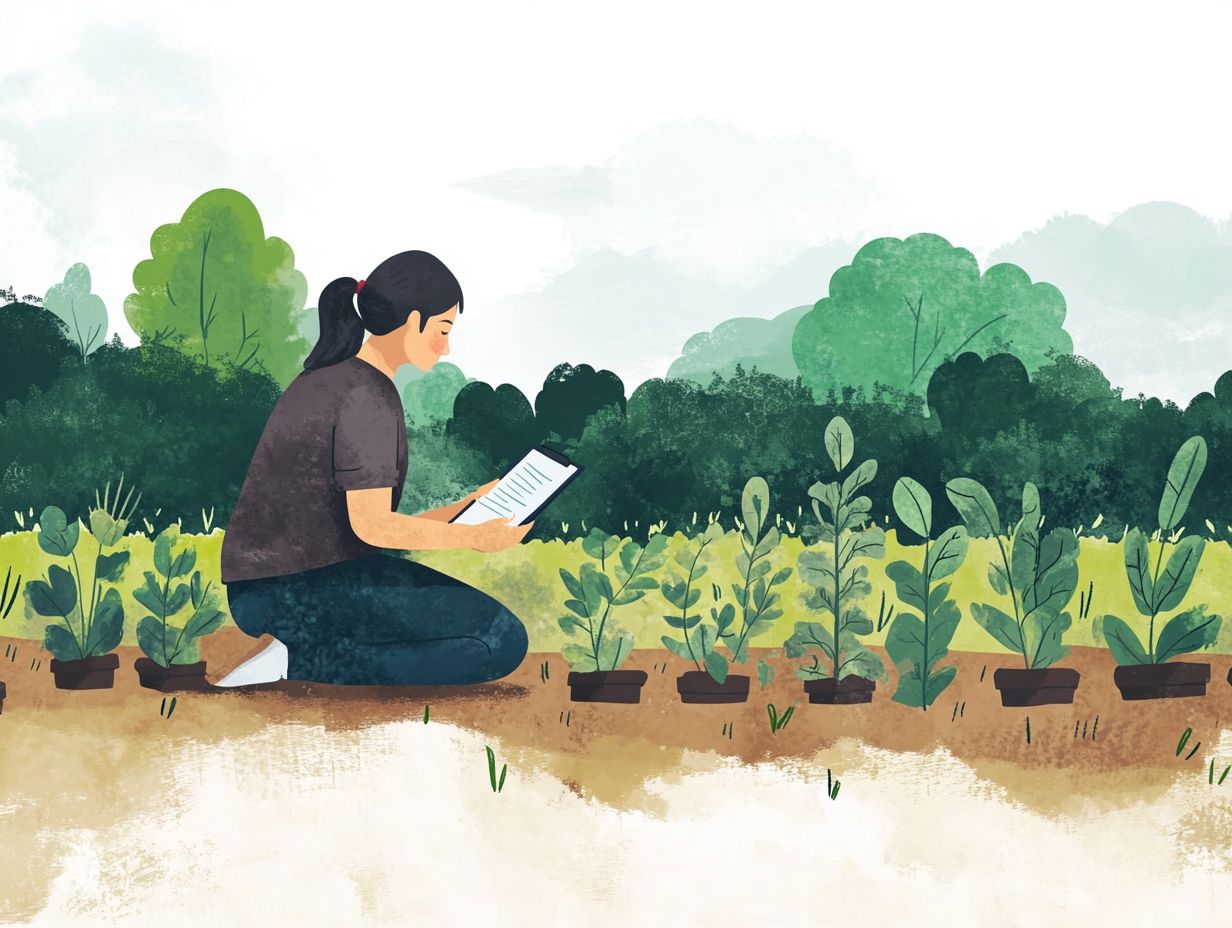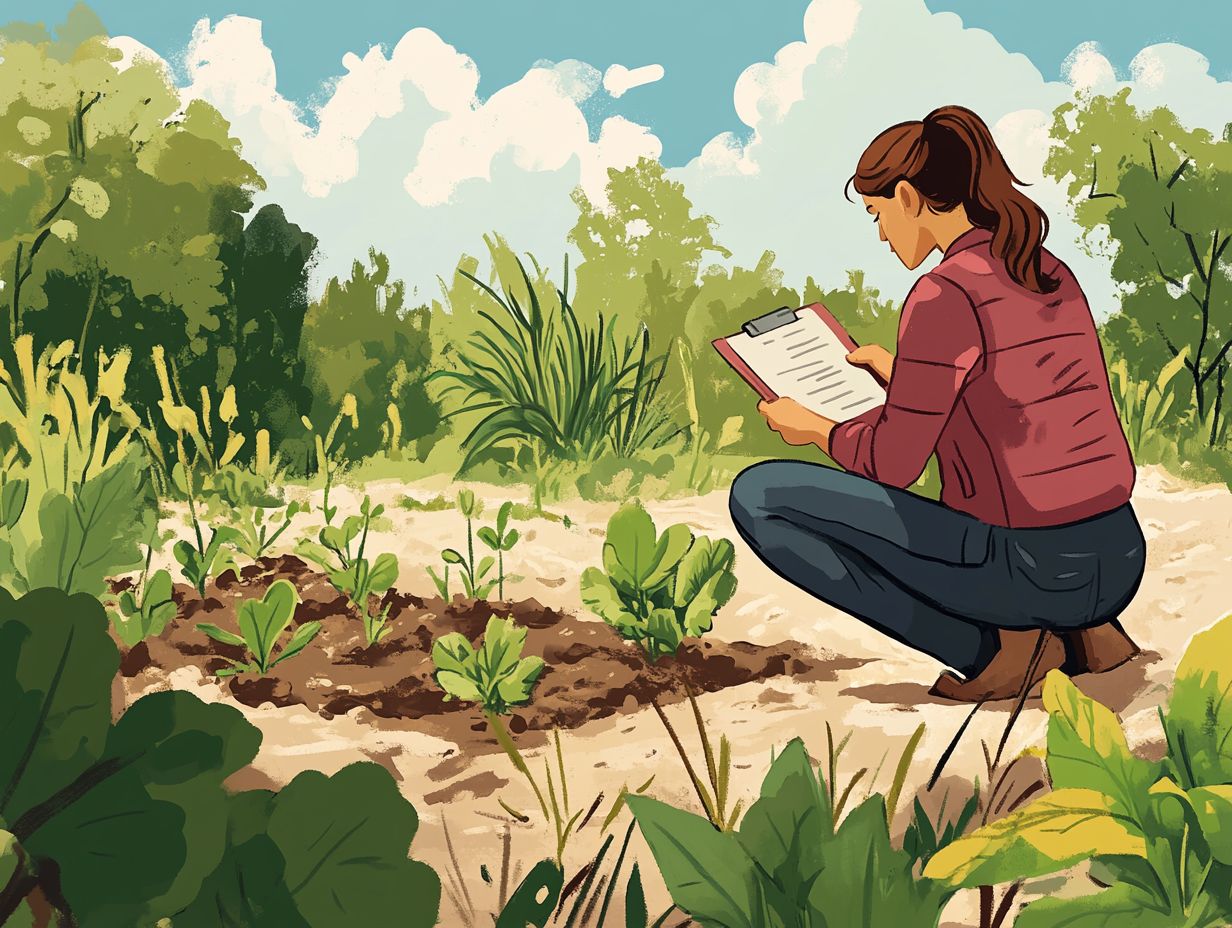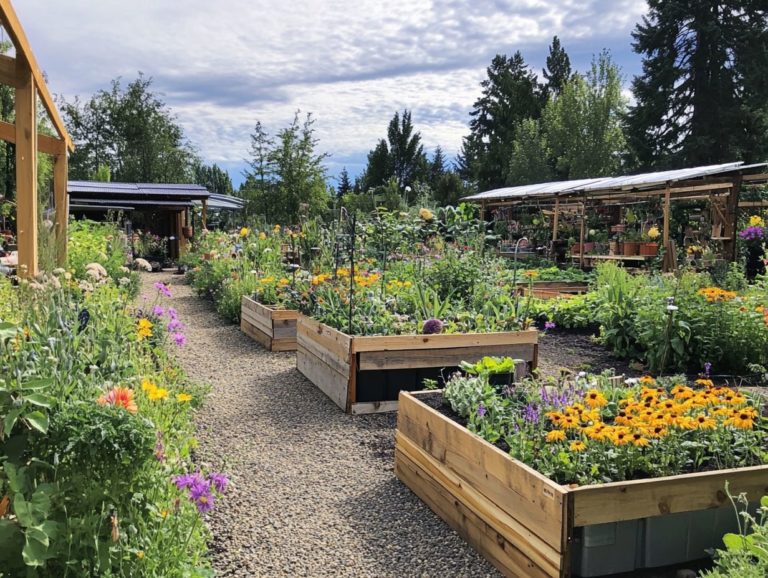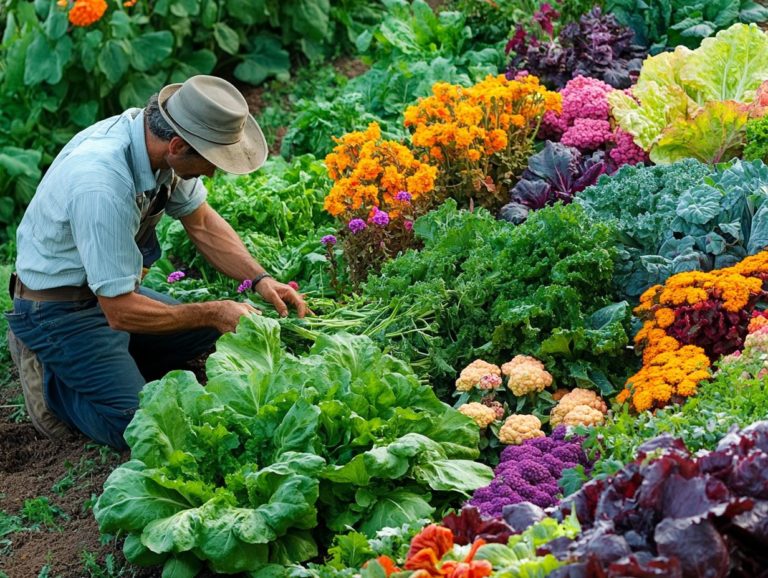How to Assess Your Land for Permaculture Use?
Transform your land today and join the movement towards a sustainable future! Permaculture presents a holistic approach to sustainable living, enabling you to transform your land into a productive, self-sustaining ecosystem.
This guide comprehensively covers the essentials of permaculture, guiding you from understanding its core principles to assessing your land for optimal use.
You will discover practical tools and techniques for design and implementation, ensuring your permaculture system flourishes.
Focusing on long-term maintenance and the myriad benefits it offers environmentally, socially, and economically this journey into permaculture is designed to inspire and empower you to cultivate a greener future through sustainable practices.
Contents
- Key Takeaways:
- Understanding Permaculture
- Assessing Your Land for Permaculture
- Designing Your Permaculture System
- Implementing Your Permaculture System
- Maintaining Your Permaculture System
- Benefits of Permaculture
- Economic Benefits
- Frequently Asked Questions
- What is permaculture and why should I be interested in using it on my land?
- How do I begin the assessment process for permaculture use on my land?
- What are some important factors to consider when assessing my land for permaculture use?
- Do I need any special equipment or knowledge to assess my land for permaculture use?
- Can I still use my land for other activities while implementing permaculture practices?
- Is permaculture only suitable for large plots of land or can it be used on smaller properties?
Key Takeaways:

- Understand the principles of permaculture and how it can benefit your land for long-term sustainability.
- Assess your land for permaculture use by considering factors such as climate, soil quality, water bodies, and available resources. Use tools and techniques to accurately evaluate your land.
- Design and implement a permaculture system on your land by creating a plan and following a step-by-step process. Maintain it with best practices for environmental, social, and economic benefits.
Understanding Permaculture
Grasping the fundamentals of permaculture is crucial for anyone eager to adopt sustainable practices that bolster variety of life, improve soil health, and foster community collaboration.
This comprehensive approach to land use employs permaculture principles to craft resilient ecosystems and regenerative agricultural methods.
By designing as a complete system, you can formulate tailored plans that consider local climate factors, historical land use, and the distinctive characteristics of your environment. A deeper understanding of permaculture empowers you with environmental science strategies that enhance land management, boost crop production, and support habitat restoration, all while ensuring long-term ecological balance and sustainability objectives.
Defining the Concept and Principles
Permaculture principles serve as the cornerstone of sustainable agriculture, guiding you to design self-sufficient ecosystems that thrive in harmony with nature.
These principles invite you to weave together crops, animals, and natural resources, enhancing variety of life while minimizing dependence on chemical inputs. Imagine a successful permaculture project where fruit trees, vegetables, and chickens coexist in a single space, facilitating nutrient cycling and natural pest management without the need for external chemicals.
Such practices align seamlessly with broader sustainability objectives by nurturing soil health and conserving water. Use techniques like mulching and companion planting to improve your understanding of ecology and create strong landscapes capable of enduring climate variability.
Assessing Your Land for Permaculture
Assessing your land for permaculture is an essential step that requires careful consideration of several key factors. This includes how to assess your site for permaculture design, analyzing the topography, and performing soil tests.
By focusing on these elements, you can ensure an optimal planning and design process that sets the foundation for a thriving permaculture system and aligns with your sustainability goals.
Factors to Consider
When you conduct a site assessment for permaculture, several critical factors demand your attention, including soil health, water conservation, and the presence of native wetland plants that enrich habitat diversity. Additionally, it’s essential to consider permaculture design: assessing and adapting, along with microclimate analysis (the specific climate conditions in a small area).
These elements collectively shape the viability and sustainability of your design. For example, assessing soil health means testing for nutrient content and pH levels, which can inform you about the types of crops best suited for your area. Water conservation strategies, such as implementing rain gardens or swales, are essential for maintaining hydration, especially in a region like USDA Plant Hardiness Zone 7a, where climate fluctuations can significantly affect moisture availability.
Incorporating native wetland plants, as demonstrated in projects at Ocean Hour Farm, not only bolsters variety of life but also plays a pivotal role in natural pest control and soil stabilization. This holistic approach creates a thriving ecosystem that benefits both your plants and the surrounding wildlife.
Get started with your own permaculture project today and make a difference!
Tools and Techniques for Assessment

Effective land assessment for permaculture requires various tools and techniques. Landscape mapping helps you visualize ecological systems and find the most suitable soil types for different crops. Understanding the steps for creating a permaculture design can further enhance your planning process.
Community collaboration is essential. It brings together diverse perspectives and expertise, enhancing your assessment’s accuracy. Tools like soil testing kits and drone technology provide vital data. Meanwhile, participatory mapping workshops allow locals to share their knowledge about the land’s history and microclimates.
Organizations like the Occidental Arts & Ecology Center show how successful assessments leverage community input to develop sustainable land use plans. The SVF Foundation exemplifies how regenerative practices thrive on collective insights, optimizing agricultural outputs.
Through these collaborative efforts, your path to achieving a resilient ecosystem and understanding design methodology becomes clearer.
Designing Your Permaculture System
Designing your permaculture system involves a thoughtful and comprehensive process. You need to consider ecological systems, develop site-specific plans, and implement core permaculture practices to enhance sustainability and resilience.
A meticulous approach ensures your design thrives in harmony with the environment and effectively follows the design process.
Creating a Plan for Your Land
Creating a comprehensive plan for your land is essential in permaculture design. Here, sustainable practices and agricultural trials test and refine your approach by integrating feedback mechanisms.
Using effective feedback mechanisms during this planning phase can significantly improve your results. For example, when establishing an agroforestry system, practitioners found that different tree species affected soil health and crop yields. By monitoring these outcomes and seeking local input, you can adjust tree placements and select more compatible varieties, fostering a more productive ecosystem.
Consider a community garden that evolved its layout based on feedback about sunlight exposure and water drainage. This quick response boosted harvest rates dramatically and increased community engagement, showcasing the power of adaptability in cultivating success.
Implementing Your Permaculture System

Implementing your permaculture system involves a clear, step-by-step approach that prioritizes forging community partnerships and fostering active engagement in habitat restoration initiatives, ensuring climate resilience.
Step-by-Step Process for Implementation
The process of implementing a permaculture system unfolds through a carefully crafted plan for farm management and crop production, focusing on climate resilience and ecological harmony.
Your journey starts with a thorough site analysis. Assess key factors like soil type, water sources, and sunlight patterns. This assessment helps you identify the best crops and companion plants, enhancing biodiversity.
Next, develop a thoughtful design layout that accounts for zones and sectors to optimize efficiency. For instance, position perennial plants near your home for easy access and less maintenance.
Then, introduce techniques like swales for effective water management or mulching to retain moisture. These approaches significantly bolster your system’s sustainability. Each step not only boosts productivity but also strengthens your ecosystem’s resilience, fostering a harmonious relationship between agriculture and nature.
Maintaining Your Permaculture System
Maintaining your permaculture system is crucial for achieving long-term sustainability. This involves embracing best practices that significantly enhance both soil health and biodiversity.
Best Practices for Long-Term Sustainability
Best practices for ensuring long-term sustainability in permaculture require you to grasp and address nutrient pollution while harnessing insights from environmental science and climate knowledge.
By implementing techniques like cover cropping and agroforestry, you can significantly enhance soil health and biodiversity. These elements are essential for creating resilient ecosystems!
Take inspiration from the Ferme de la Tour project in France. This project showcases how strategies like crop rotation and intercropping create stunning environmental and economic successes through careful planning.
Research from the Regenerative Agriculture Initiative reveals that balanced pest control not only reduces your reliance on chemical inputs but also promotes natural pest predation. This strengthens the overall health of the ecosystem. By embracing these proven methods, you can cultivate systems that endure and thrive, effectively tackling the challenges posed by climate change and nutrient loss.
Benefits of Permaculture
The advantages of permaculture extend far beyond environmental enhancements. They encompass substantial social and economic benefits that nurture community collaboration and enrich habitat diversity.
By embracing these principles, you contribute to a healthier ecosystem and foster a sense of unity and resilience within your community.
Environmental Benefits
The environmental benefits of permaculture are remarkable. They lead to a rich tapestry of biodiversity, enhanced soil quality, and more effective water management.
When implemented skillfully, you can see a staggering 50% increase in native species diversity. Numerous community projects worldwide provide evidence of this success. For instance, in Australia, permaculture practices revitalized a degraded landscape, bringing back over 70 native flora and fauna species in just five years.
By incorporating organic matter through permaculture techniques, you significantly boost soil health. This improves its ability to retain water by up to 30%. Such practices foster sustainable agriculture while reducing the risks of flooding and drought, showcasing the holistic advantages of this thoughtful approach to land management.
Social Benefits
The social benefits of permaculture are equally significant. They cultivate community partnerships and create valuable educational opportunities while advancing habitat restoration efforts.
When you engage in permaculture practices, you’re not just learning about sustainable land management. You’re also forging stronger relationships with those around you, exchanging knowledge and resources.
Consider local permaculture projects that often involve collaborative gardening. Neighbors come together to transform their spaces into edible landscapes! These initiatives yield fresh produce and foster a sense of belonging and shared purpose.
Participating in such projects can lead to greater ownership of your local environment, resulting in increased stewardship. Successful examples abound, like the community gardens in Detroit and the urban permaculture initiatives in Portland. These showcase how collective efforts breathe new life into neighborhoods while promoting biodiversity and resilience against climate challenges.
Economic Benefits

Permaculture has clear economic benefits. You can see increased crop production, better farm management, and more resilience to climate changes.
By integrating diverse plant species and building mutual benefits among them, you can enhance your output while reducing reliance on chemicals. One Australian farm saw a stunning 40% increase in yields in just three years by focusing on soil health.
These practices lead to healthier crops and reduced operational costs. With the booming market for organic produce, now is the perfect time to adopt permaculture!
Frequently Asked Questions
What is permaculture and why should I be interested in using it on my land?
Permaculture is a sustainable approach to land use that creates a harmonious relationship between humans and nature. It promotes practices like organic farming and water conservation. Using permaculture can benefit the environment, boost your self-sufficiency, and reduce your ecological footprint.
How do I begin the assessment process for permaculture use on my land?
The first step is to observe and analyze your land’s current condition. Look at soil quality, water sources, climate, and possible hazards. To effectively design your space, consider how to understand and use permaculture principles while assessing your goals, resources, and limitations before creating your permaculture plan.
What are some important factors to consider when assessing my land for permaculture use?
In addition to natural conditions, consider the social and cultural aspects of your land. Think about the local community, laws, and any cultural significance of the area. These factors are key to a sustainable permaculture system.
Do I need any special equipment or knowledge to assess my land for permaculture use?
No special equipment or expertise is required to begin the assessment process. However, it’s wise to educate yourself on permaculture principles and techniques, and seek guidance from experienced permaculturists.
Can I still use my land for other activities while implementing permaculture practices?
Yes, permaculture is flexible and can fit various land uses. You can engage in recreational activities or farming while implementing permaculture practices, which can enhance sustainability.
Is permaculture only suitable for large plots of land or can it be used on smaller properties?
Permaculture can be applied to any size of land, from small backyards to large farms. The principles are adaptable and can even work in urban settings like rooftop gardens.
Start your permaculture journey today to explore the benefits it can bring to your land!






